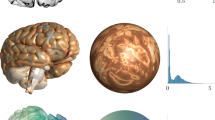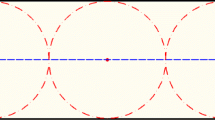Abstract
In this paper, we propose the conformal energy minimization (CEM), stretching energy minimization (SEM) and volume stretching energy minimization (VSEM) algorithms by using the Jacobi conformal projection to compute the ellipsoidal conformal, area- and volume-preserving parameterizations from the boundary of a simply connected closed 3-manifold \(\mathcal {M}\) to the surface of an ellipsoid \(\mathcal {E}^3(a,b,c)\) and from the 3-manifold \(\mathcal {M}\) to an ellipsoid \(\mathcal {E}^3(a,b,c)\), respectively. At each correction step of SEM and VSEM, the coefficients of the Laplacian matrices are modified by imposing local area/volume stretch factors in the denominators. Furthermore, to find the area-preserving optimal mass transportation (OMT) map between \(\partial \mathcal {M}\) and \(\partial \mathcal {E}^3(a,b,c)\) and the volume-preserving OMT map between \(\mathcal {M}\) and \(\mathcal {E}^3(a,b,c)\), in light of SEM and VSEM, we propose the ellipsoidal area-preserving OMT (AOMT) and volume-preserving OMT (VOMT) algorithms, which are combined with the project gradient method, while preserving the local area/volume ratios and minimizing the transport costs and distortions. The numerical results demonstrate that the transformation of a 3D irregular image into an appropriate ellipsoid or cuboid incurs a smaller transport cost and reduces the difference in the conversion compared with that into a ball or cube.
Similar content being viewed by others
References
Large-Scale Bounded Distortion Mappings. https://shaharkov.github.io/LargeScaleBD.html. Accessed 25 December 2018
David Xianfeng Gu’s Home Page. http://www3.cs.stonybrook.edu/~gu/ (2017)
Iso2Mesh. http://iso2mesh.sourceforge.net (2018)
Antonelli, M., Reinke, A., Bakas, S., Farahani, K., et al.: The medical segmentation decathlon. Preprint at arxiv:2106.05735 (2021)
Bakas, S., Akbari, H., Sotiras, A., Bilello, M., et al.: Advancing the cancer genome atlas glioma MRI collections with expert segmentation labels and radiomic features. Sci. Data 4, 170117 (2017)
Bakas, S., Reyes, M., Jakab, A., et al.: Identifying the best machine learning algorithms for brain tumor segmentation, progression assessment, and overall survival prediction in the BRATS challenge. Preprint at arxiv:1811.02629 (2019)
Bonnotte, N.: From Knothe’s rearrangement to Brenier’s optimal transport map. SIAM J. Math. Anal. 45(1), 64–87 (2013). https://doi.org/10.1137/120874850
Brenier, Y.: Polar factorization and monotone rearrangement of vector-valued functions. Commun. Pure Appl. Math. 44(4), 375–417 (1991). https://doi.org/10.1002/cpa.3160440402
Caffarelli, L.A.: The regularity of mappings with a convex potential. J. Am. Math. Soc. 5(1), 99–104 (1992). http://www.jstor.org/stable/2152752
Engwirda, D.: Locally optimal Delaunay-refinement and optimisation-based mesh generation. Ph.D. thesis, The University of Sydney (2014)
Engwirda, D.: Voronoi-based point-placement for three-dimensional Delaunay-refinement. Procedia Eng. 124, 330–342 (2015)
Engwirda, D.: Conforming restricted Delaunay mesh generation for piecewise smooth complexes. Procedia Eng. 163, 84–96 (2016)
Engwirda, D., Ivers, D.: Face-centred Voronoi refinement for surface mesh generation. Procedia Eng. 82, 8–20 (2014)
Engwirda, D., Ivers, D.: Off-centre Steiner points for Delaunay-refinement on curved surfaces. Comput. Aided Des. 72, 157–171 (2016)
Floater, M.S., Hormann, K.: Surface parameterization: a tutorial and survey. In: Advances in Multiresolution for Geometric Modelling, pp. 157–186. Springer Berlin Heidelberg (2005)
Garg, V., Jaakkola, T.: Solving graph compression via optimal transport. In: Advances in Neural Information Processing Systems, pp. 8014–8025. Curran Associates, Inc. (2019)
Grimmett, G., Stirzaker, D.: Probability and random processes. Oxford university press (2020)
Gu, X.D., Yau, S.T.: Computational Conformal Geometry, vol. 1. International Press Somerville, MA (2008)
Haker, S., Zhu, L., Tannenbaum, A., Angenent, S.: Optimal mass transport for registration and warping. Int. J. Comput. Vis. 60, 225–240 (2004)
Haralick, R.M., Shapiro, L.G.: Computer and robot vision, vol. 1. Addison-wesley Reading (1992)
Hormann, K., Lévy, B., Sheffer, A.: Mesh parameterization: Theory and practice. In ACM SIGGRAPH Course Notes (2007)
Jacobi, C.G.J., Borchardt, C.W.: Vorlesungen über Dynamik. G. Reimer (1866)
Jacobson, A.: common-3d-test-models. https://github.com/alecjacobson/common-3d-test-models (2021)
Kolouri, S., Park, S.R., Thorpe, M., Slepcev, D., Rohde, G.K.: Optimal mass transport: Signal processing and machine-learning applications. IEEE Signal Process. Mag. 34, 43–59 (2017)
Kolouri, S., Tosun, A.B., Ozolek, J.A., Rohde, G.K.: A continuous linear optimal transport approach for pattern analysis in image datasets. Pattern Recognit. 51, 453–462 (2016)
Kovalsky, S.Z., Aigerman, N., Basri, R., Lipman, Y.: Large-scale bounded distortion mappings. ACM Trans. Graph. 34(6), 191:1–191:10 (2015). https://doi.org/10.1145/2816795.2818098
Lei, N., Su, K., Cui, L., Yau, S.T., Gu, X.D.: A geometric view of optimal transportation and generative model. Comput. Aided Geom. Des. 68, 1–21 (2019)
Li, P., Wang, Q., Zhang, L.: A novel earth mover’s distance methodology for image matching with Gaussian mixture models. In: Proceedings of the IEEE International Conference on Computer Vision (ICCV), pp. 1689–1696 (2013)
Lin, W.W., Juang, C., Yueh, M.H., Huang, T.M., Yau, S.T.: 3D brain tumor segmentation using a two-stage optimal mass transport algorithm. Sci. Rep. 11, 14686 (2021)
Menze, B.H., Jakab, A., Bauer, S., Kalpathy-Cramer, J., et al.: The multimodal brain tumor image segmentation benchmark (BRATS). IEEE Trans. Med. Imag. 34(10), 1993–2024 (2015)
Nyrtsov, M.V., Fleis, M.E., Borisov, M.M., Stooke, P.J.: Jacobi conformal projection of the triaxial ellipsoid: new projection for mapping of small celestial bodies. In: Cartography from Pole to Pole, pp. 235–246. Springer Berlin Heidelberg (2014)
Parikh, N., Boyd, S.: Proximal algorithms. Foundations and Trends in optimization 1(3), 127–239 (2014)
Rubner, Y., Tomasi, C., Guibas, L.J.: The earth mover’s distance as a metric for image retrieval. Int. J. Comput. Vis. 40, 99–121 (2000)
Simpson, A.L., Antonelli, M., Bakas, S., Bilello, M., et al.: A large annotated medical image dataset for the development and evaluation of segmentation algorithms. Preprint at arxiv:1902.09063 (2019)
Su, K., Chen, W., Lei, N., Zhang, J., Qian, K., Gu, X.: Volume preserving mesh parameterization based on optimal mass transportation. Comput.-Aided Design 82, 42–56 (2017). https://doi.org/10.1016/j.cad.2016.05.020
Wang, W., Slepcev, D., Basu, S., Ozolek, J.A., Rohde, G.K.: A linear optimal transportation framework for quantifying and visualizing variations in sets of images. Int. J. Comput. Vis. 101, 254–269 (2013)
Yoshiyasu, Y., Ma, W.C., Yoshida, E., Kanehiro, F.: As-conformal-as-possible surface registration. Comput. Graph. Forum 33(5), 257–267 (2014)
Yueh, M.H., Huang, T.M., Li, T., Lin, W.W., Yau, S.T.: Projected gradient method combined with homotopy techniques for volume-measure-preserving optimal mass transportation problems. J. Sci. Comput. 88(64), 1–24 (2021). https://doi.org/10.1007/s10915-021-01583-z
Yueh, M.H., Li, T., Lin, W.W., Yau, S.T.: A novel algorithm for volume-preserving parameterizations of 3-manifolds. SIAM J. Imag. Sci. 12(2), 1071–1098 (2019). https://doi.org/10.1137/18M1201184
Yueh, M.H., Lin, W.W., Wu, C.T., Yau, S.T.: An efficient energy minimization for conformal parameterizations. J. Sci. Comput. 73(1), 203–227 (2017). https://doi.org/10.1007/s10915-017-0414-y
Yueh, M.H., Lin, W.W., Wu, C.T., Yau, S.T.: A novel stretch energy minimization algorithm for equiareal parameterizations. J. Sci. Comput. 78(3), 1353–1386 (2019). https://doi.org/10.1007/s10915-018-0822-7
Acknowledgements
The authors thank Professor Mei-Heng Yueh of National Taiwan Normal University for providing Fig. 3 for this paper.
Funding
The work of J.-W. Lin, W.-W. Lin, and T.-M. Huang was partially supported by the Ministry of Science and Technology (MoST) 110-2811-M-A49-534 and 110-2115-M-003-012-MY3, respectively, in Taiwan. The work of T. Li was partially supported by the National Natural Science Foundation of China (NSFC) Grant 11971105. The work of the authors was partially supported by the National Center for Theoretical Sciences (NCTS) in Taiwan, and the Big Data Computing Center in Southeast University, China.
Author information
Authors and Affiliations
Corresponding author
Ethics declarations
Competing interests
The authors declare no competing interests.
Additional information
Communicated by: Raymond H. Chan
Publisher's Note
Springer Nature remains neutral with regard to jurisdictional claims in published maps and institutional affiliations.
Appendix: Discrete 3-Manifold and Associated Ellipsoid
Appendix: Discrete 3-Manifold and Associated Ellipsoid
Let \(\mathcal {M}\) be a simplicial 3-complex with a genus-zero boundary. Suppose the volume of \(\mathcal {M}\) is one and the volume center lies at the origin. First, we need to determine the size of the ellipsoid to which \(\mathcal {M}\) is mapped, i.e., we need to determine three principal semiaxes \(a,b,c\,\) of the desired ellipsoid. This is the ellipsoid fitting problem, which is commonly seen in various fields. To this end, in view of probability theory and statistics, we adopt the concept of central moments [17] in statistics. Suppose that the cardinality of \(\mathbb {V}(\mathcal {M})\) is N and \(v_i=(x_i,y_i,z_i)\in \mathbb {V}(\mathcal {M})\) for \(i=1,2,\ldots ,N\). The covariance matrix is
where \(\bar{x}=\sum _{i=1}^N x_i/N, \bar{y}=\sum _{i=1}^N y_i/N\) and \(\bar{z}=\sum _{i=1}^N z_i/N\). The matrix K is positive definite because all vertices are not in the same plane. In addition, all eigenvalues of K are positive, with corresponding eigenvectors orthogonal to each other. We develop a method, specified in Algorithm 7, to estimate three semiaxes and the orientation of the ellipsoid using the eigenvalues and the eigenvectors, respectively [20]. Additionally, using this method, we obtain a closed curve \(\gamma _A\), which corresponds to the ellipse \(\{(x,y,0)\in \mathbb {R}^3~|~\frac{x^2}{a^2}+\frac{y^2}{b^2}=1\}\), and two vertices \(v_1\) and \(v_2\), which correspond to \((-a,0,0)\) and (a, 0, 0) of \(\mathcal {E}^3(a,b,c)\), respectively. These objects are necessary for the ellipsoidal CEM algorithm.

Ellipsoid fitting.
Rights and permissions
Springer Nature or its licensor (e.g. a society or other partner) holds exclusive rights to this article under a publishing agreement with the author(s) or other rightsholder(s); author self-archiving of the accepted manuscript version of this article is solely governed by the terms of such publishing agreement and applicable law.
About this article
Cite this article
Lin, JW., Li, T., Lin, WW. et al. Ellipsoidal conformal and area-/volume-preserving parameterizations and associated optimal mass transportations. Adv Comput Math 49, 50 (2023). https://doi.org/10.1007/s10444-023-10048-w
Received:
Accepted:
Published:
DOI: https://doi.org/10.1007/s10444-023-10048-w
Keywords
- Ellipsoidal conformal
- Area- and volume-preserving parameterizations
- Discrete optimal mass transportation
- Jacobi conformal projection
- Simplicial 3-complex with a genus-zero boundary





